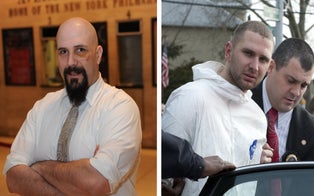Volunteers as far as France come each year to clean his headstone.
When artist Jean-Michel Basquiat passed away inside his Manhattan loft of a heroin overdose at the age of 27 on Aug. 12, 1988, the world mourned.
Thirty years after his passing, he is far from forgotten. Basquiat is now celebrated in music, fashion, film and modern art. And every year, a group of volunteers come from as far away as France to clean his grave inside Brooklyn’s massive Green-Wood Cemetery.
The pilgrimage is coordinated by Preservation Volunteers, an organization that brings people together to clean and restore graves inside Green-Wood as well as historic areas of Staten Island each summer.
“It is important to be able to pay respects to people who were here long before us, and in doing so, we learn a little bit about the history,” Dexter Guerrieri, president and founder of Preservation Volunteers, told InsideEdition.com.
Basquiat was born in the Bushwick section of Brooklyn in 1960 to a Haitian father and mother of Puerto Rican descent. He rose to prominence in the 1980s as a Manhattan street artist and member of a punk band before eventually landing his work in local art galleries, where his fame skyrocketed.
Since his death, however, Basquiat has only grown more famous.
“Does [his work] have relevance today? Yes, it shows he was a great artist of that time and student of that time,” art critic and historian Antwaun Sargent told InsideEdition.com. “He is a cultural touchstone.”
His simple gray grave features his name centered above the word “artist,” with the months of his birth and death below.
"Whenever someone comes out to visit Green-Wood and they say, ‘Where is Jean-Michel Basquiat’s grave?’ and they find it, a lot of people are surprised it is quite small," Neela Wickremesinghe, manager of restoration and preservation at Green-Wood, told InsideEdition.com. "He definitely warrants a larger-than-life monument, but the humbleness of its size, I think, is actually quite fitting for his art and the role that he plays in New York."
Preservation Volunteers has been going to Green-Wood for 14 years to clean graves in need of TLC. But Basquiat’s headstone is a fairly recent addition.
“We were actually the first volunteers to ever work here at Green-Wood,” Guerrieri said. “Two years ago, people were coming from France and wanted to know where was Basquiat’s grave. So, to clean it made sense.”
Preservation Volunteers director Anna added, “I am happy to be here because it is such an impressive cemetery especially for us coming from France, where it is really different. It is such a huge space. Everything in America is huge.”
Even though Green-Wood uses volunteers to help clean graves across the 478-acre cemetery, it has a full-time staff that does the bulk of the maintenance year-round, working with products that are specifically formulated to not kill the grass and trees.
In addition to Basquiat, the cemetery is the final resting places of composer Leonard Bernstein, the Steinway piano family, infamous New York City politician William “Boss” Tweed, and Dr. Susan McKinney Steward, the third African-American woman to ever earn a medical degree. The historic cemetery, which was founded in 1838, is also the resting ground of more than 5,000 soldiers who fought in the Civil War.
Basquiat’s grave is one of the cemetery’s “most visited sites,” Wickremesinghe said. Fans leave pens, pencils, stones, markers, paintbrushes and notes, and even scrawl his signature three-prong crown on the headstone. The grave is so popular that security checks on it every weekend.
“Last year, when we were cleaning the headstone, a yellow cab came up [and] two very well-dressed people came out of the cab, laid down 12 yellow roses and left,” she recalled.
"We came to Green-Wood Cemetery because we wanted to find Basquiat's grave," a New Yorker named Emma told InsideEdition.com. "Why would I care about him? He died so young. We wouldn't have graffiti if it wasn't for him. He was a brilliant artist, on so many levels and in some ways I worship him and I'm 71 years old."
The late artist’s work reflected on social issues such as economic inequality, slavery, white supremacy, police brutality and race relations during the 1980s.
“In the ‘80s, black culture was becoming much more noticed by the white mainstream, thanks to things like hip-hop music and breakdancing, and I think Jean-Michel was part of putting a spotlight on black culture in a way that the art world usually didn’t pay attention to because they can be racist. But his genius broke through those barriers and they had to take notice of him,” columnist Michael Musto told InsideEdition.com.
Contemporary artist Bradley Theodore added that the late creator’s work is particularly special for black artists.
“I think that in the ‘80s to have a black artist become prominent within high society, that was special. There’s a combination of pop art and protest art with tribal art that merged together and that’s what made him extra special at that time,” he said.
In 2017, Basquiat was behind one of the most expensive works of a U.S. painter and African-American artist ever sold. His 1982 “Untitled” piece sold for $110.5 million to a Japanese billionaire.
“Market prices are now reflecting his talent,” Sargent said. “When an artist dies, their value goes up.”
Basquiat’s legacy looms large over modern art and pop culture, but the fact that volunteers come from across the globe to preserve his headstone is a testimony to his international staying power, Sargent added.
“I think it is great and touches on his undying influence not just in New York City but globally,” he said.
“I think it shows a lot of respect. I hope they come to my grave when I die,” Musto added. “I think they should even maybe do some graffiti on his grave. I think he would’ve approved.”
Graffiti is sometimes found on Basquiat’s headstone, Wickremesinghe said. While she agrees with Musto that Basquiat would likely approve, she urges visitors to leave notes or pictures instead because graffiti is bad for the stone itself.
“We don’t want to cause permanent damage,” she said.
But Basquiat would have been touched by the volunteers’ dedication, Theodore said.
“If you have people that come all the way from France to clean his grave, I think that’s honorable. There’s a lot of people that have achieved and added to our society that we just forgot,” he said. “For these people to say, ‘You know, every year we’re going to get together and celebrate this person’s life by honoring them by cleaning their grave,’ that’s a very beautiful thing.”
RELATED STORIES





